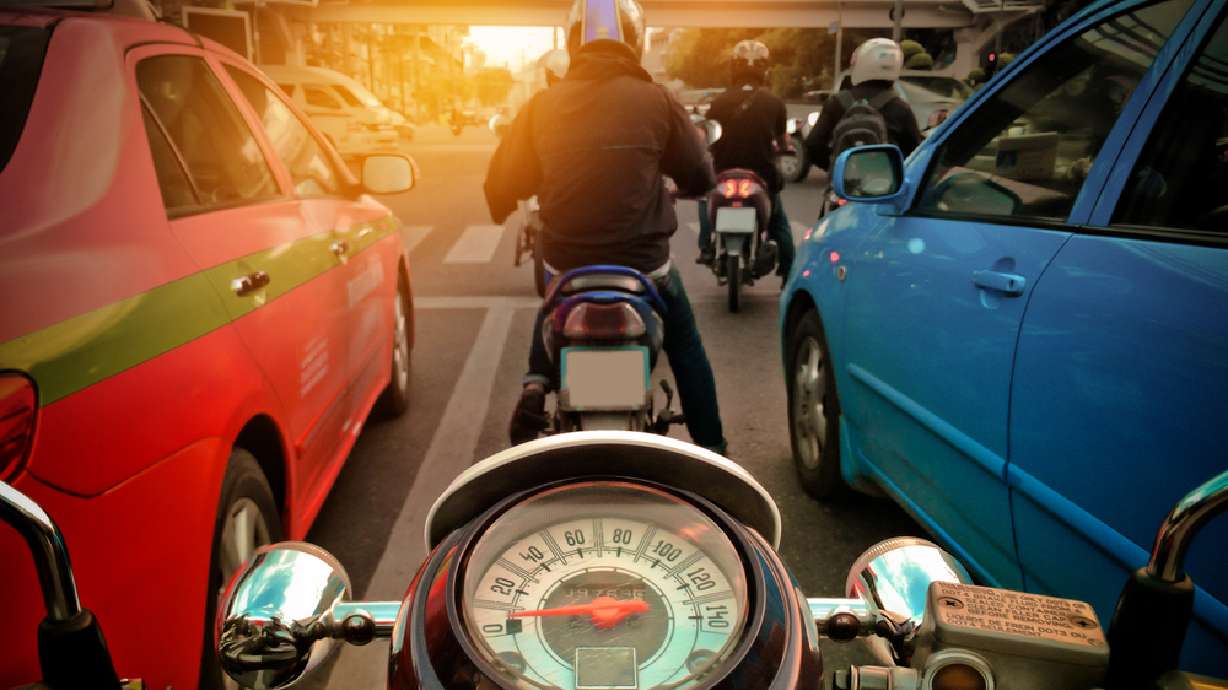Estimated read time: 5-6 minutes
This archived news story is available only for your personal, non-commercial use. Information in the story may be outdated or superseded by additional information. Reading or replaying the story in its archived form does not constitute a republication of the story.
SALT LAKE CITY — Motorists will soon see something new on some of Utah’s roadways. Come May 14, motorcyclists will be able to “filter” to the front of traffic at stops on the state’s major roads.
That’s when Utah’s latest traffic law, which was signed by Gov. Gary Herbert last week, takes effect.
However, Utah Highway Patrol is alerting motorists about a month and a half before the law goes into effect so they won’t be caught off guard.
“A lot of people are hearing this and they tune it out because it doesn’t apply to them. But you’re going to be woefully surprised when that loud (motorcycles) come in between the lanes between your car and another car,” said Utah Highway Patrol Sgt. Nick Street. “I hope that it doesn’t agitate behavior to where they feel like someone’s cutting in line. There’s a reason the law’s been made to where they can cut in line.”
What is ‘lane filtering”?
Under the new law, UHP states:
- Motorcyclists can move to the front of a traffic light on roads where the speed limit is 45 mph or less and has two or more adjacent traffic lanes in the same direction of travel.
- Motorcyclists can only move to the front when vehicles are stopped.
- Motorcyclists can’t move more than 15 mph when filtering lanes.
“Splitting can be done at freeway speeds in California. … Motorcyclists are not supposed to exceed the speed limit, but as cars are slowing down due to traffic and things like that, motorcyclists can go in between the cars. That’s splitting traffic,” he said. “What we have is when cars are stopped, motorcycles can filter to the front on a red light or they can filter through traffic during a crash and cars are stopped.
“They can only do it in Utah when cars are stopped. Once the cars start moving, it’s illegal for them to continue.”
There is still a subjective nature to the law, Street added. The law says the maneuvering around lanes has to be done “safely.” What some people think is safe may not be how others feel.
They can only do it in Utah when cars are stopped. Once the cars start moving, it’s illegal for them to continue.
–UHP Sgt. Nick Street
As a motorcyclist himself, Street said hopes others like him will use good judgment.
“I hope they use due diligence and care not to try to do it where they’re really going to be threading the needle to where they have a lane that’s wide enough to accommodate if their bike has saddlebags or longer handlebars,” he said. “If you take off a car’s mirror, that’s on you. You’re going to have to stop, talk to the police and file an accident report.”
Where will this be allowed?
Filtering is limited to roads where the speed limit is 45 mph or less and there are multiple lanes going in the same direction.
Here’s a few of those as an example to help illustrate where this will be legal:
- 700 East, Foothill Boulevard, Redwood Road and State Street in Salt Lake County
- 800 North (Orem), 1600 North (Orem), Geneva Road and State Street in Utah County
- Antelope Drive, Harrison Boulevard, Park Lane, Parrish Lane, Riverdale Road, Washington Boulevard in Davis/Weber counties
Why the bill was pushed forward
Department of Public Safety officials were initially skeptical with the idea at first, but it changed through the discussions of HB149 based on some of the statistics brought up, Street said. There were more than 1,200 motorcyclists rear-ended from 2011 through 2017 on Utah streets, he added.
“We see rear-enders all the time with cars and it’s just cosmetic. You take it to the body shop. Things aren’t great. We prefer it doesn’t happen, but it happens quite a bit,” Street said. “When you rear-end a motorcycle, there’s typically going to be an injury involved, if not, a fatality. … As a motorcyclist myself, I like the idea that I can get off that ‘X’ of danger.”
The DPS still hasn’t released final 2018 crash numbers, but there were already more motorcycle deaths on Utah roads by the start of Sept. 2018 than all of 2017.
While not all of those deaths were related to cars rear-ending motorcycles, Elvecia Ramos, founder of the Riderz Foundation, testified during a Senate committee hearing about HB149 that she knew someone who was involved in a fatal rear-ending crash last year.
“She and her husband got rear-ended and, unfortunately, her husband died,” Ramos told the committee on Feb. 25. “We really need to have this bill because it’s really going to save a lot of people’s lives.”
Related:
She endorsed the bill and encouraged that all motorists would be educated about the new law.
Scott Thompson, of Lindon, told the same committee that traffic filtering helped him tremendously in the 25 years he spent as a police officer in California. That’s why he supported the bill as a Utah resident during a Senate committee meeting in February.
“I was able to move up, safely riding between the natural gaps in traffic and get to where I was going quicker and more efficiently,” Thompson told the committee that day.
Street believes the new law will make it safer for motorcyclists and help declutter traffic because motorcyclists won’t have to take up space behind a traffic light.
He added if the law change doesn’t go well, it could be phased out in 2022 and lane filtering would be illegal again.
Contributing: Mark Jackson, KSL Newsradio











